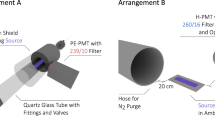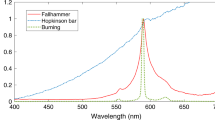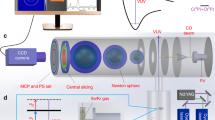Abstract
IN a recent paper1 it has been shown that carbon dioxide, when excited to luminescence by an electrical discharge in a vacuum tube, possesses a blue-violet afterglow having a spectrum similar to that obtained by burning carbon monoxide in air or oxygen. The spectrum has now, on the suggestion of Prof. A. Fowler, been produced from a modified source which is brighter than the afterglow in the gas at low pressure.
This is a preview of subscription content, access via your institution
Access options
Subscribe to this journal
Receive 51 print issues and online access
$199.00 per year
only $3.90 per issue
Buy this article
- Purchase on Springer Link
- Instant access to full article PDF
Prices may be subject to local taxes which are calculated during checkout
Similar content being viewed by others
References
Proc. Roy. Soc., A, 142, 362; 1933.
Author information
Authors and Affiliations
Rights and permissions
About this article
Cite this article
GAYDON, A. Afterglow of Carbon Dioxide. Nature 133, 984–985 (1934). https://doi.org/10.1038/133984b0
Issue Date:
DOI: https://doi.org/10.1038/133984b0
Comments
By submitting a comment you agree to abide by our Terms and Community Guidelines. If you find something abusive or that does not comply with our terms or guidelines please flag it as inappropriate.



